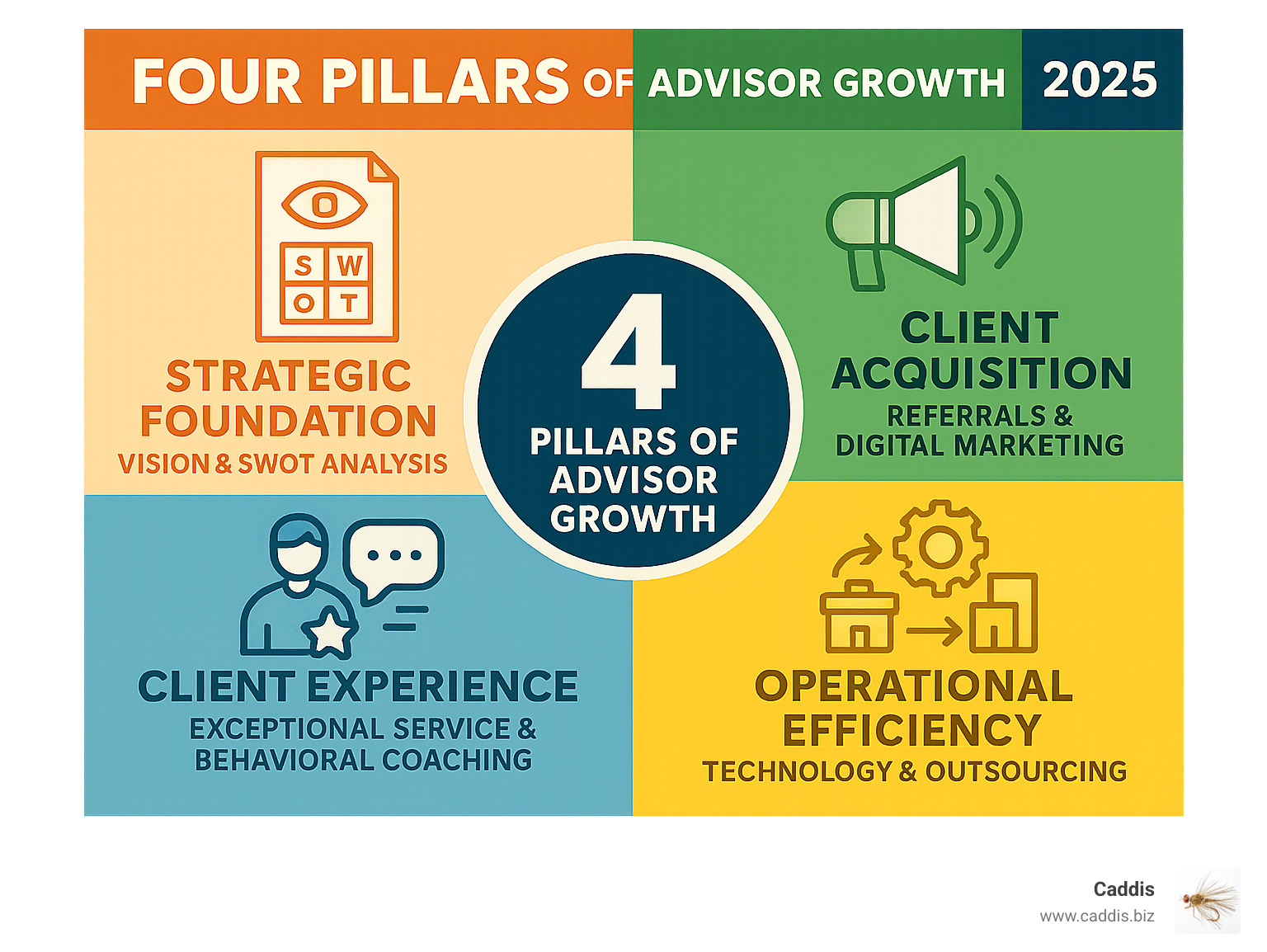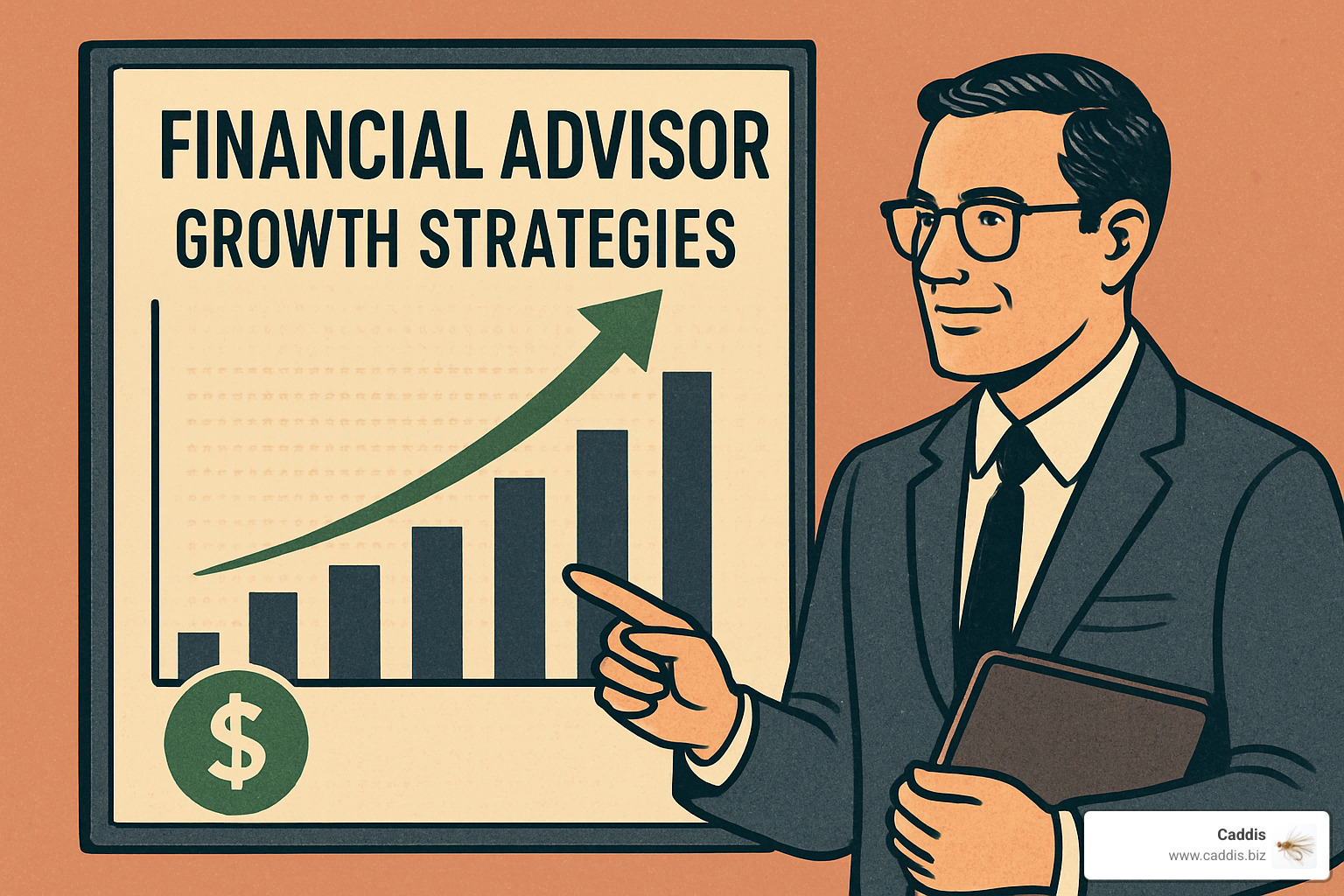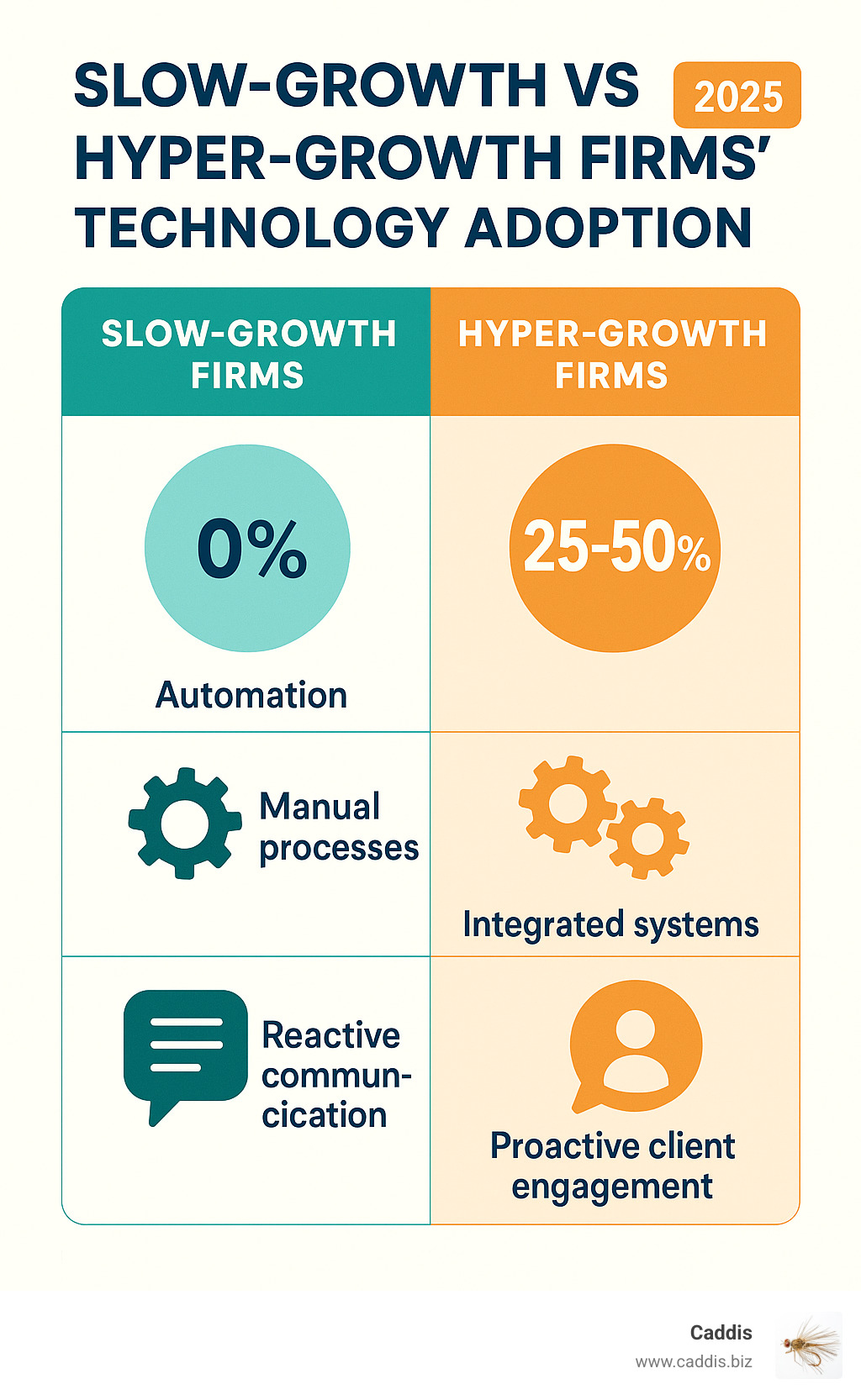Why Financial Advisor Growth Strategies Are Critical in Today’s Market
Financial advisor growth strategies have never been more crucial as the industry faces unprecedented consolidation and a historic wealth transfer opportunity. Here are the essential strategies for scaling your practice:
Core Growth Pillars:
- Strategic Foundation – Develop clear vision, niche targeting, and SMART goals
- Client Acquisition – Master referrals, digital marketing, and community engagement
- Client Experience – Deliver exceptional service and evolve into a behavioral coach
- Operational Efficiency – Leverage technology and strategic outsourcing
The harsh reality is that most advisory firm growth over the past decade came from market appreciation, not organic client acquisition. With nearly $3 trillion in assets under management expected to change hands in the next 10 years and 15% of RIAs controlling over 85% of industry assets, the window for building a scalable practice is narrowing.
The consolidation data tells the story: RIAs have driven up valuations over 50% in just three years, while firms with $1 billion or more in assets dominate growth. Top-performing firms with strategic plans see twice the annualized revenue growth compared to those without.
This isn’t just about adding clients – it’s about building a business that can thrive independent of market conditions. The advisors who accept systematic growth strategies today will be the ones who capture disproportionate value from the coming wealth transfer.
I’m Jeff Mount Caddis, and I help financial advisors implement customized sales and business strategies to achieve scalable growth through proven financial advisor growth strategies. My approach combines strategic planning with tactical execution, much like the patience and adaptability required in fly fishing.

Laying the Foundation for Sustainable Growth

Think of building a successful advisory practice like constructing a house. You wouldn’t start with the roof, right? The same principle applies to financial advisor growth strategies – everything starts with a rock-solid foundation.
Here’s what the numbers tell us: firms with formal strategic plans achieve twice the annualized revenue growth and nearly three times the net asset flows compared to those winging it. That’s not coincidence – that’s the power of intentional planning.
Your strategic foundation begins with three critical elements. First, define your firm’s vision, purpose, and core values. This isn’t just feel-good material for your website. It’s your North Star, guiding every decision from which clients to accept to how you spend your marketing budget.
Next, conduct a thorough SWOT analysis to honestly assess your internal strengths and weaknesses alongside external opportunities and threats. Maybe you’re great with high-net-worth clients but struggle with digital marketing. Or perhaps there’s a wave of business owners retiring in your area, but new fintech competitors are emerging.
From there, establish SMART goals that connect your big-picture vision to specific, measurable outcomes. Top-performing advisors accept what we call the “relentless prospector mindset” – treating every conversation as a potential opportunity while genuinely caring about client outcomes.
The research reveals that growth-minded advisors share three key traits: unwavering belief in their value proposition, systematic prospecting habits, and strategic capacity management. The good news? These aren’t personality traits you’re born with – they’re learnable skills that separate thriving practices from lifestyle businesses.
Understanding KPIs: The Hard Truth About Winning In Business becomes essential here. Track metrics like prospects contacted per month, meeting conversion rates, and revenue per client to measure progress against your strategic goals.
Developing Financial Advisor Growth Strategies Through Niching
A counterintuitive truth: the narrower your focus, the faster you’ll grow. Advisors who specialize earn an average of 12% more than generalists. Niching doesn’t just attract ideal clients; it actively repels those who don’t fit your model.
Building an Ideal Client Profile (ICP) goes beyond demographics. The fastest-growing advisors develop detailed psychographic profiles that include their ideal clients’ values, communication preferences, and decision-making styles. This lets you speak directly to your audience’s specific needs.
Consider successful niches like retirement planning for small business owners or wealth management for physicians. Each combines a life situation with a specific audience. The key is selecting a niche that aligns with your expertise and interests. A narrow focus amplifies your marketing effectiveness and referral potential. When you’re known as “the advisor for divorced women,” referrals become much more targeted.
You’ll find additional strategic planning resources in our More info about Business Planning section.
Building a Growth-Oriented Mindset and Skillset
The financial advisory landscape changes quickly, making continuous learning non-negotiable for sustainable growth.
Russell Investments’ Value of an Advisor study shows a particular uptick in the value that advisors deliver through behavioral coaching – but only if they’ve actually developed those skills. You can’t fake expertise in client psychology.
Professional development should focus on three core areas. Technical competence keeps you current with tax law changes, investment strategies, and regulatory requirements. Behavioral coaching has become increasingly valuable as modern clients need guidance on decision-making, not just portfolio management. Business skills like marketing, sales, and operations management aren’t optional anymore. The most successful advisors think like business owners, not just investment professionals.
We’ve found that advisors who commit to structured learning programs see measurable improvements in both client satisfaction and business growth. The importance of being a continuous learner cannot be overstated in today’s competitive environment.
Building a sustainable practice requires the same long-term thinking as managing a baseball season. Our insights on Managing A Financial Advisory Business Is Like A 162-Game MLB explore this analogy in depth, showing how consistent daily actions compound into extraordinary results.
Proven Financial Advisor Growth Strategies for Client Acquisition

Here’s the uncomfortable truth: most advisory firm growth over the past decade came from market appreciation, not from actually acquiring new clients. While that might have worked when markets were climbing, it’s a dangerous strategy moving forward.
The advisors who will thrive in the coming years are those who master financial advisor growth strategies focused on organic client acquisition. This means building repeatable systems that bring in qualified prospects month after month, regardless of what the S&P 500 is doing.
Think of client acquisition like a funnel. At the top, you need multiple channels generating leads. In the middle, you need processes to nurture those leads. At the bottom, you need conversion strategies to turn prospects into clients. The key is tracking your numbers at each stage to know where to focus your time and budget.
If you’re ready to build systematic sales processes that actually work, check out our More info about Sales resources.
Master the Art of Referrals and Introductions
Referrals are still the lifeblood of advisory growth. Research shows that 85% of ultra-wealthy individuals prefer referral-based advisors. But most advisors treat referrals as a passive hope instead of an active strategy.
Identify your “influencer clients”—those natural connectors who enjoy sharing positive experiences. Instead of an awkward ask, try creating urgency and exclusivity: “I can only take on five new households this quarter. Is there anyone in your network who might be a good fit?”
Centers of Influence (COIs) like attorneys and CPAs are another goldmine. Make referrals easy for them with a simple one-page summary of your ideal client and services. Schedule quarterly meetings where you provide value, not just ask for business. The magic happens when you’re proactive. Build referral requests into your regular client review process.
For proven referral techniques, you can explore resources like Top referral tips for financial advisors.
Digital Marketing: A Core Component of Modern Financial Advisor Growth Strategies
Digital marketing is essential, not optional. You just need to be consistent and authentic.
Personal branding starts with your online presence, especially your LinkedIn profile. It should tell your story clearly and professionally. Think of it as your digital business card that works 24/7.
Content creation demonstrates your expertise. Answer the questions your clients ask every day in blog posts or short videos. The goal isn’t to go viral—it’s to show your knowledge to the right people.
Your social media strategy should focus on LinkedIn, where your ideal clients and referral sources spend their professional time. Share insights and engage authentically with your network.
SEO for advisors helps people find you. The five essential on-page SEO elements are:
- Title tags with target keywords and location
- Meta descriptions that encourage clicks
- Header tags to structure content
- Local business schema to help search engines
- Internal linking to connect related pages
Digital marketing is a marathon, not a sprint. For comprehensive strategies, visit our More info about Marketing section.
Leverage Seminars and Community Engagement
In our digital world, in-person events are powerful for building trust. Seminars and workshops remain highly effective when done right. Target a 0.4-1% response rate from direct mail, plan for 15-20% no-shows, and aim for 40% appointment-setting rates from attendees. The key is following up within 48 hours with personalized messages.
Webinars offer personal connection with broader reach. Always offer recorded sessions for those who can’t attend live, but emphasize the value of real-time Q&A.
Community involvement builds your reputation organically. Sponsor local events, volunteer for causes you care about, and participate in professional organizations. Choose activities that align with your values and client base. People do business with people they know, like, and trust. Community engagement builds all three.
Amplify Growth Through Client Experience and Retention

Here’s something that might surprise you: keeping your existing clients happy drives growth far more effectively than constantly chasing new ones. The numbers tell a compelling story – existing clients convert to new services at rates up to 70% compared to just 5-20% for brand new prospects.
Think about it this way. You’ve already built trust, demonstrated value, and understand their needs. Why wouldn’t you maximize these relationships before burning energy on cold prospects?
The math gets even more interesting when you look at client segmentation. Most advisory practices follow the 80/20 rule – about 80% of revenue comes from the top 20% of clients. But here’s the real eye-opener: often just 5% of revenue comes from the bottom 50% of clients. This is what we call the 5/50 rule.
This data should reshape how you allocate your time. Your top-tier clients deserve white-glove treatment, while lower-tier clients can still receive excellent service through more efficient systems. This approach doesn’t just improve client satisfaction – it turns your best clients into your most effective referral sources.
Smart financial advisor growth strategies recognize that client retention is the foundation everything else builds on. For deeper insights on sustainable growth practices, check out our thoughts on Your Company Must Grow Right Now!.
Deliver Exceptional, Differentiated Service
Investment performance has become commoditized. Your service experience is what determines whether clients stay, refer others, and expand their relationship with you.
Client roadmaps are a great tool for demonstrating ongoing value. These visual representations show each client’s financial journey, making abstract concepts tangible. Scheduled contact is also critical. Implement systematic communication schedules based on your client segments. The key isn’t frequency – it’s consistency and relevance.
Proactive communication separates good advisors from great ones. Reach out before clients ask questions. Send market updates during volatility, tax planning reminders before year-end, and congratulations on personal milestones. This positions you as a trusted advisor who’s thinking about them.
A simple tactic that works wonders is to surprise and delight clients with personalized gifts or messages. Small gestures build emotional connections that transcend business relationships. The goal is creating a service experience so exceptional that clients naturally want to share it.
Evolve into a Behavioral Coach
The Russell Investments Value of an Advisor study shows the value from behavioral coaching has increased dramatically. Modern clients need guidance on decision-making and behavior modification, not just portfolio management.
Think about what your clients really struggle with: sticking to long-term plans during market turbulence, making spending decisions that align with financial goals, and facilitating difficult family conversations about money. This evolution requires developing new skills in psychology and communication, but it pays dividends through deeper client relationships and higher retention.
Holistic financial wellness means addressing the emotional and psychological aspects of money. Your ability to guide these conversations creates immense value that clients can’t get from robo-advisors. The advisors who successfully make this transition find their practices become more fulfilling and profitable.
To learn more about this evolution, explore Accept a new identity: that of a behavioral life coach and our More info about Financial Advisors resources.
Create Capacity with Technology and Operational Efficiency

Creating capacity for growth requires strategic use of technology and operational efficiency. The data shows that slow-growth firms are 1.5 times more likely to have no automation in client communication, while hyper-growth firms automate 25-50% of their communications.
This isn’t about replacing human interaction – it’s about freeing up time for high-value activities like client meetings and strategic planning. Successful advisors use technology for routine tasks while focusing personally on relationship building.
Scalability depends on building systems that work without constant oversight. This approach not only improves efficiency but also increases business valuation by reducing owner dependence.
For comprehensive guidance on improving business value, explore How Financial Advisors Can Increase Income And Improve Business Valuation.
Accept Automation and Technology
Modern advisory practices require a robust, integrated technology stack. The most important systems include:
- CRM Systems: Centralize client information, track interactions, and automate follow-ups.
- Marketing Automation: Automate email sequences, social media posting, and lead nurturing.
- Client Portals: Provide 24/7 access to account information, documents, and planning tools.
- Reporting and Analytics: Automate performance reporting and client communications.

The key is choosing tools that integrate well. Start with core functions and gradually add capabilities as your practice grows.
For detailed automation strategies, review Automation tools in sales enablement.
Strategically Outsource to Focus on Core Strengths
Strategic outsourcing allows you to focus on activities that directly drive growth. The most successful advisors identify their unique value proposition and delegate everything else.
- Investment Management: Outsourcing portfolio management frees up significant time for client relationship building.
- Administrative Tasks: Delegate scheduling, data entry, and routine client service to qualified staff or virtual assistants.
- Specialized Services: Partner with insurance specialists, tax professionals, and estate planning attorneys to provide comprehensive solutions.
The goal is creating a business model where you spend most of your time on activities that only you can do – building relationships, providing strategic advice, and growing the practice.
For more insights on effective outsourcing, explore our More info about Business Strategy.
Frequently Asked Questions about Financial Advisor Growth
What does “growth” truly mean for a financial advisor today?
True growth today isn’t just about AUM. It’s about building a resilient business that thrives in any market. This means focusing on organic client acquisition (net new assets), increasing revenue per client, improving profit margins, and enhancing enterprise value. Shifting focus from AUM to metrics like net new asset flows creates a sustainable practice that isn’t at the mercy of market volatility.
What is the most effective way to acquire new clients?
While digital marketing is important, referrals from satisfied clients and strategic partnerships remain the most effective channels for acquiring quality clients. The data shows 85% of ultra-wealthy individuals prefer referral-based advisors. The key is to deliver exceptional service and create a systematic process for asking for introductions to both clients and Centers of Influence (COIs) like CPAs and attorneys. Digital marketing then works to amplify these efforts and establish your credibility online.
How can a solo advisor or small firm implement these strategies?
Don’t get overwhelmed by trying to do everything at once. Start with one or two key areas and execute them consistently.
First, define a specific niche. This single decision makes all other marketing efforts more effective. Second, leverage technology and automation for routine tasks like client communication and scheduling. This creates capacity for high-value activities that only you can do.
Finally, strategically outsource non-essential tasks as you grow. This could include administrative work or investment management. The goal is to be strategic with the resources you have. Small, consistent actions compound into significant results over time.
Conclusion
Building a thriving advisory practice today requires implementing financial advisor growth strategies that create sustainable growth, independent of market conditions. Success comes from deliberate action across four areas: strategic foundation, client acquisition, exceptional service, and operational efficiency. With a historic wealth transfer underway and industry consolidation accelerating, the advisors who commit to systematic growth will capture the most value.
Don’t try to implement every strategy at once. Choose strategies that align with your strengths, execute them consistently, and then build from there. The key is taking action. The data is clear: firms with strategic plans see twice the annualized revenue growth, and specialists earn more than generalists.
Success demands commitment, strategic thinking, and consistent execution. It’s about viewing your practice as a business to be grown, not just a lifestyle to be maintained. At Caddis, our SalesQB framework helps advisors build scalable systems that create value. The choice is yours: rely on the market or take control of your future. The most successful advisors decide to stop waiting and start building.
Ready to transform your practice? Learn how a Fractional Chief Revenue Officer can transform your business and start implementing these growth strategies today.


